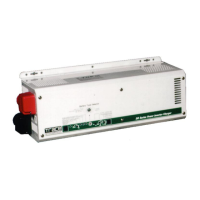Trace Engineering DR Series Owner’s Manual - Version 3.2 - 9/7/98 - Page 30
Operation
The power switch of one unit turns both inverters on and off, this unit becomes the “master”. The other
unit is the “slave” and will follow the master throughout its modes of operation. Whichever unit is
turned on first becomes the master inverter.
For example, the inverters will both charge when AC line power is available to the master unit. This will
take place after the generator spin-up delay of approximately 40 seconds has passed. Accordingly,
both units will transfer back to inverter mode when the master unit senses a loss of AC input power.
The only situation in which the slave may shut down the master inverter is with fault conditions such as
hi/low battery, overcurrent, or overtemperature conditions. Both inverters will auto reset after a fault
condition has been cleared. The exception is that an overcurrent condition will generate a shutdown
for both inverters that will require a manual restart of the system.
NOTE: The DR series inverters, unlike the “U series”, are series stacking, meaning the outputs are
connected in series thus doubling the voltage to 240 VAC. The DR inverters cannot be paralleled to
double power at 120VAC.
Theory of Operation
The stacked inverters are designed to accept power input from a split-phase, 3 wire 120/240 VAC
system, 120 volts to each inverter. The HOT IN terminal of each inverter accepts one leg of 120 volts
each and the NEUTRAL IN terminals of both inverters tie together and connect to the system power
neutral leg.
Any AC loads being powered while AC input is present to the inverters will be in addition to the power
being drawn for battery charging. Each unit of the pair can provide full pass through current of 30
amps for 120 volt systems, while simultaneously supporting full charging current of 35 amps each at
24 volts DC or 70 amps total, or 70 amps each at 12 volts DC or 140 amps total.
When AC input power is lost, the units switch from charger to inverter mode. Once this switch is made
120 VAC is available from each individual inverter, or 240 VAC is available across the HOT OUT
terminals of the stacked pair.
Stacked inverters will typically support about twice the surge power of one stand-alone unit when
powering 240VAC loads. For example, a DR1524 stacked pair will surge about 9000 watts of
incandescent lights. Keep in mind that typical incandescent light bulbs require about five times normal
run current at start up.
Search Mode Operation with Stacked Pairs
When two DR inverters are stacked, the search control on the master unit will determine how much
load must be present to “wake-up” both inverters. As a result, loads that will be used to bring the
inverters out of search mode must be wired to the master unit’s 120 VAC output or across both units
240 VAC output. Refer to the section on Search Mode Watts on page 5 for operation of the search
mode control.

